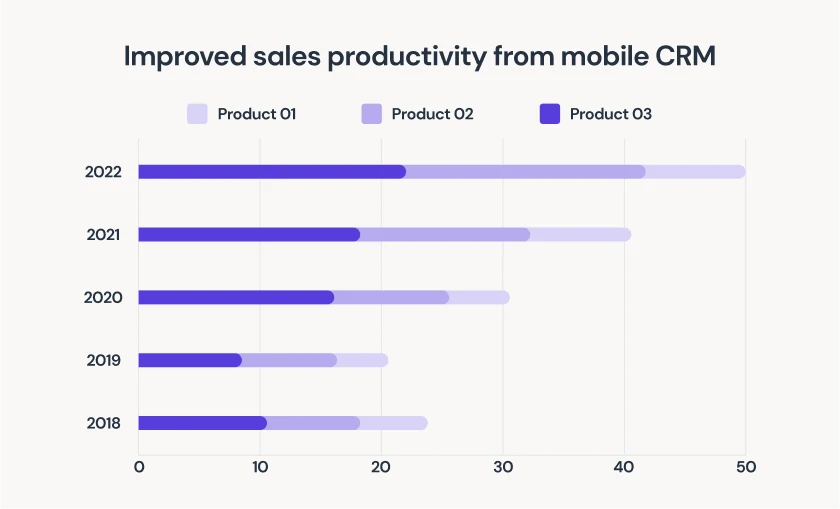A sales pitch deck is a powerful tool that enhances your pitch or demo to potential clients. Think of them as storytelling magic, bringing your key points to life, showcasing social proof, and presenting impressive data.
But if you've been struggling to close deals on your recent sales calls, it might be time for a pitch deck makeover.
Ready to transform your sales deck into a deal-closing powerhouse? Follow our guide for crafting a winning sales deck that will leave your prospects eager to say "yes!"
Define your target audience
Think about who will be sitting across the table from you when you present your pitch deck.
Consider their job roles, industry, and what makes them tick. By identifying their specific needs, pain points, and interests, you can tailor your pitch to speak directly to them. When crafting your narrative, make sure to put their needs front and center. Show them how your offering can be the answer to their specific problems.
Research your audience
The main focus of a sales pitch should be the client, so make sure you know your audience. You want to show them that you have taken the time to understand their business and the challenges they're facing.
Dive deep into their industry and competitors and research any market trends that might impact them. You might also consider using a sales enablement or digital sales room platform. By doing your homework, you can position your pitch as a solution that's perfectly aligned with their needs. It shows that you've taken the time to understand their world and offer something relevant.
Tailor your message
Nobody likes a generic sales pitch that feels like it could be for anyone; they want a story that speaks directly to them.
Avoid a one-size-fits-all pitch about how great your company and offerings are, and instead aim for personalized conversations that address their pain points directly and show them how your product or service can be the solution they've been searching for.
The art of structuring your pitch
Start with a strong opening
Think of your pitch deck as a story and your opening slide as the captivating opening chapter. You need a hook that instantly grabs your audience's attention and makes them eager to hear more.
This could be a thought-provoking question, for example, "What if you could double revenue while cutting costs?" or an intriguing data point like "Did you know that 60% of CEOs struggle with employee retention?".
You could even lead with a bold statement that challenges the status quo, such as “The analytics industry will be redundant in 3 years”. These attention-grabbing techniques are guaranteed to captivate your audience from the start.
Define the problem
Resist the urge to jump straight into your solution.
Instead, take a moment to highlight the problem your product or service addresses. This is known as the problem statement and sets the foundation for your pitch.
"Consider the challenges faced by your sales team when it comes to managing leads and closing deals. Tracking leads across various stages, staying on top of follow-ups, and effectively nurturing prospects can be time-consuming and complex. Without a streamlined CRM system, sales reps may experience missed opportunities, lack of visibility into the sales pipeline, and difficulty accurately forecasting revenue."
By outlining the problem in a relatable and detailed manner, you allow your prospect to acknowledge and relate to the difficulties they encounter. They can envision its impact on their team's efficiency and overall success.
Focus on benefits (not features)
Now, it's time to introduce your solution. Since your prospects have already envisioned the potential results, they are more receptive to discussing the specifics of your product or service.
However, remember not to dwell too much on the technical features of your offering. Instead, extract the benefits from each feature and emphasize those.
Building on our previous example, you could approach it like this:
"Our cutting-edge CRM system, with CTI Salesforce integration, revolutionizes how businesses manage customer relationships. With this powerful solution, you not only gain a comprehensive view of each customer but also seamlessly connect their communication interactions directly to their CRM profiles.
This integration empowers your sales and support teams to deliver personalized experiences at every touchpoint, resulting in stronger customer loyalty, increased sales conversions, and an overall improvement in customer satisfaction."
Continue the conversation along these lines, highlighting the unique benefits your product provides and how it precisely addresses the needs of your prospects.
By focusing on the benefits rather than just the features, you showcase the value your solution brings to their specific pain points. This approach ensures that your prospects understand how your product or service directly meets their needs and solves their challenges.
Paint a vivid picture of your solution in action
The key here is to transport your prospects into a future where they're actively using your product to tackle a persistent problem head-on.
Let's consider an example where you're selling a customer analytics platform. As a sales representative in this scenario, you have the opportunity to guide your prospects on an exciting journey where they harness the power of their vast data reserves effortlessly. No more grappling with manual data processing and analysis — instead, they have a comprehensive analytics solution right at their fingertips.
Paint a picture of the platform implementation becoming a reality.
They effortlessly navigate through data visualizations, uncovering hidden patterns and making informed decisions using your customer intelligence systems. They spot untapped opportunities, optimize their operations, and deliver personalized experiences to their customers, all thanks to your advanced analytics platform. It's a shift from traditional guesswork to data-backed decision-making, propelling their business forward.
The key here is to transport your prospects into a future where they actively use your product to address and solve a persistent problem.
By contrasting this seamless experience with their current challenges around collating and analyzing data, you help them realize the potential of your product. The goal is to paint a compelling picture for the prospect.
By engaging their imagination and appealing to their desires, you establish a strong emotional connection and make your solution more tangible and appealing. This visualization reinforces how your product can transform their lives and provide the solution they've been seeking.

Back your pitch with compelling facts and data
To make your sales pitch truly effective, it's essential to ground it in solid facts and data.
Including verifiable facts and figures can disarm even the most skeptical prospects and eventually persuade them.
Remember, a pitch backed by facts, data, and social proof is not only persuasive but also helps build trust and confidence in your offering.
- Testimonials that speak volumes: Let your satisfied clients do the talking for you. Share their heartfelt testimonials that highlight the amazing experiences they've had doing business with you. For an extra dose of credibility, consider including real pictures or video testimonials of your clients.
- Back it up with research data: Boost your pitch with research data and expert quotes that align with your product's benefits. When you bring in authoritative voices and credible statistics, you provide concrete evidence supporting your claims and building trust.
- Leverage Analytics: Use data data analytics to showcase the success stories of existing clients and demonstrate the tangible results they have achieved through your product or service. By presenting data-driven insights, you strengthen your credibility and show potential clients the real value they can expect.
- Show why you're the best: Make a compelling comparison between your product and your competitors. Demonstrate how your solution outshines the rest, whether it's through unique features, superior quality, or exceptional customer support. This will help your audience see why choosing you is the smartest decision.
- Go the extra mile with added benefits: Offer something extra to seal the deal. Consider providing a money-back guarantee or a free trial period. These enticing perks demonstrate your confidence in your product and give your prospects the peace of mind they need to take the leap.
Conclude with a strong call-to-action
After laying a strong foundation with your sales messaging, it's time to determine the desired action you want your customers to take based on their unique requirements and business goals. Your CTA (call-to-action) is your opportunity to leave a lasting impression and guide your prospect toward the next steps.
Structure your presentation like a reverse pyramid, with broad messaging at the beginning and gradually narrowing down to the specific needs of your customers and how your solution meets those needs. Finally, culminate your pitch with a sharp and compelling call to action that serves as the culmination of your presentation.
Keep it simple; make your CTA count
Keep it simple and impactful when crafting your CTA. Avoid overwhelming your prospect with complex instructions. Instead, make the next step a single, straightforward action that is easy to remember and execute.
Make your CTA unique and tailored to your prospect's goals or challenges. Avoid generic statements like "consider us for your business" and instead offer a personalized next step that aligns with their specific needs. Stand out by suggesting a specific action, such as "Based on your desire to streamline operations and reduce costs, let's schedule a demo of our supply chain optimization technologies to show you how our solution can optimize your supply chain and drive significant savings."
Set a timeline
Finally, include a timeframe to create a sense of urgency and prompt your prospect to take action. For example, suggest scheduling a deep dive with their support team within the next 30 days, ensuring there is a defined timeline for progress.
Create a sales pitch deck that connects with your audience
The key to a successful pitch is starting off by setting the scene and highlighting the challenges that your clients are facing. When you do that, you immediately position yourself as someone who truly gets what's going on in their world.
Creating value, building trust, and presenting your product as the perfect solution to their needs within a short timeframe is an art form. But don't worry; by following the steps we've outlined above, you'll be well-equipped to deliver a smooth and compelling pitch that hits the mark with your audience.




